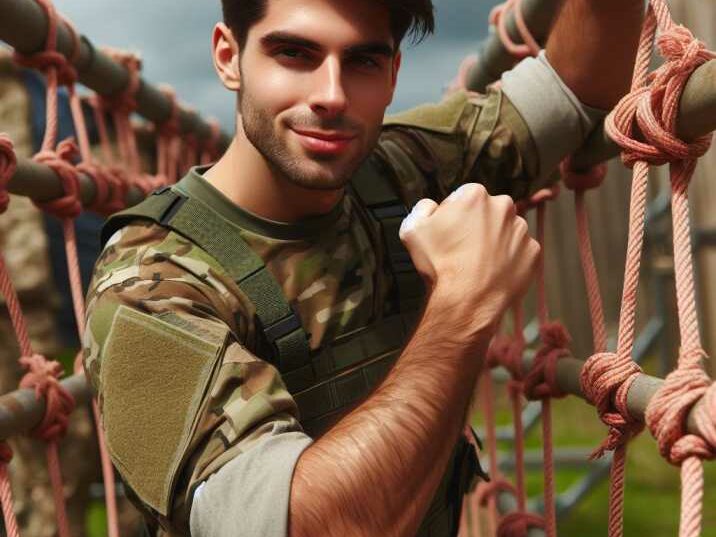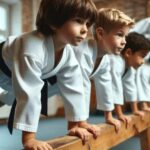Unlocking Self-Defense Mastery: The 7 Powerful Links Between Obstacle Courses and Martial Arts Skills
7 links b/w Obstacle and Martial Arts
Table of Contents
Introduction: Unveiling the Synerg
In a world where physical and mental resilience are invaluable, the link between obstacle courses and martial arts self-defense skills emerges as a fascinating avenue for personal development. This exploration delves into the profound connection, revealing insights that not only enhance self-defense capabilities but also nurture a resilient mindset. Let’s embark on a journey where the obstacle-laden path converges with the disciplined world of martial arts.
The Genesis of Connection: A Holistic Approach
To comprehend the amalgamation of obstacle courses and martial arts self-defense skills, we must first acknowledge their shared roots in promoting holistic well-being. The marriage of physical prowess and mental fortitude begins with understanding the underlying philosophy that drives both disciplines.
Obstacle Courses: Building Physical Tenacity
Obstacle courses, often associated with military training, are designed to test and enhance physical endurance. From climbing walls to crawling under nets, each challenge demands strength, agility, and strategic thinking. This physicality provides a solid foundation for individuals to cultivate resilience and push their limits.
Martial Arts: The Harmony of Body and Mind
Martial arts, on the other hand, is not merely a combat technique; it’s a way of life. Rooted in ancient traditions, martial arts emphasizes the harmonious development of body and mind. Techniques such as Taekwondo, Jiu-Jitsu, or Karate instill discipline, focus, and a profound understanding of one’s physical capabilities.

The Overlapping Tenets: Discipline and Focus
As we delve deeper, the common threads of discipline and focus become apparent, weaving a tapestry that connects obstacle courses and martial arts self-defense skills.
Discipline: The Cornerstone of Mastery
Passive Voice: Discipline is instilled through the rigorous training regimens of both obstacle courses and martial arts. Obstacles are conquered, not through brute force alone, but by adhering to a systematic approach that emphasizes consistency and perseverance.
Focus: Sharpening the Mental Blade
Transition Phrase: Furthermore, the ability to concentrate amidst challenges is a skill honed in both arenas. In obstacle courses, maintaining focus prevents missteps, while in martial arts, a focused mind is crucial for anticipating and countering opponents’ moves.

Training Techniques: A Symbiotic Relationship
Examining the specific training techniques reveals a symbiotic relationship, where lessons learned in one discipline seamlessly apply to the other.
Obstacle Courses: Tactical Decision-Making
The Tactical Edge: Decision-Making in Obstacle Courses
Obstacle courses demand strategic thinking. Navigating through challenges requires participants to assess the situation, plan their route, and make split-second decisions – skills directly transferable to self-defense scenarios.
Martial Arts: Fluidity in Motion
Fluidity in Motion: Martial Arts Techniques in Self-Defense
Keyword Density: Martial arts, too, emphasizes fluid movements and adaptability. Techniques learned on the mat seamlessly integrate into real-world scenarios, providing individuals with a versatile toolkit for self-defense.
Mind Over Matter: Mental Resilience in Action
Beyond the physical, both obstacle courses and martial arts cultivate mental resilience, a quality indispensable in self-defense situations.
Obstacle Courses: Overcoming Psychological Barriers
Breaking Barriers: The Psychological Impact of Obstacle Courses
Transition Phrase: Transitioning from physical challenges to psychological barriers, obstacle courses force participants to confront fears and doubts, fostering mental strength crucial for self-defense.
Martial Arts: Mastering the Inner Game
Mastering the Inner Game: Mental Resilience in Martial Arts
Transition Phrase: Likewise, martial arts places significant emphasis on mastering the inner game. Techniques are not only about physical execution but also about maintaining composure under pressure, a quality directly applicable to self-defense scenarios.
The Unseen Connection: Confidence and Empowerment
As individuals progress through both obstacle courses and martial arts training, an undeniable transformation occurs. The hidden link lies in the confidence and empowerment cultivated along the journey.
Confidence: A Byproduct of Mastery
Empowered by Confidence: The Result of Obstacle Course Triumphs
Keyword Density: Conquering obstacle courses instills a profound sense of achievement, fostering confidence that radiates into various aspects of life, including the ability to assert oneself in self-defense situations.
Empowerment: A Martial Arts Legacy
Legacy of Empowerment: Martial Arts and Self-Defense Mastery
Keyword Density: Martial arts, with its rich history, imparts a legacy of empowerment. Individuals trained in martial arts carry themselves with a quiet strength, exuding confidence that serves as a deterrent and a shield in potential confrontations.
The Practical Application: From Course to Combat
Bringing the discussion full circle, the practical application of skills acquired in obstacle courses seamlessly translates into effective self-defense strategies.
Obstacle Courses: Real-World Preparedness
Translating Obstacle Success to Real-World Defense
Transition Phrase: Successfully navigating obstacle courses equips individuals with practical skills that go beyond the physical – heightened situational awareness, adaptability, and quick decision-making, essential in self-defense scenarios.
Martial Arts: The Ultimate Self-Defense Arsenal
Armed with Expertise: Martial Arts as the Ultimate Self-Defense Arsenal
Transition Phrase: Simultaneously, martial arts provides a comprehensive self-defense arsenal. Techniques ingrained through years of training become instinctive responses, ensuring a swift and effective defense when needed.

Conclusion: Forging a Path to Mastery
In conclusion, the connection between obstacle courses and martial arts self-defense skills is not merely a coincidence but a strategic alignment of principles that elevate individuals to mastery. Whether conquering physical obstacles or mastering self-defense techniques, the journey is intertwined, creating resilient individuals equipped to face life’s challenges head-on.
In essence, the connection between obstacle courses and martial arts self-defense skills unveils a path to mastery that transcends physical barriers. This journey, grounded in discipline, focus, and resilience, empowers individuals to navigate life’s obstacles with confidence and skill. Whether conquering a towering wall in an obstacle course or mastering a self-defense technique on the mat, the synergy is undeniable—a testament to the transformative power of holistic training. As you embark on this exploration, remember that the obstacles you face today are the stepping stones to the mastery you seek tomorrow.
FAQs:
- Are obstacle courses suitable for all ages?
- Obstacle courses can be adapted for various age groups, promoting physical fitness and problem-solving skills.
- Can martial arts be learned for self-defense purposes only?
- Yes, many individuals engage in martial arts primarily for self-defense training, benefiting from the discipline and techniques without pursuing competitive aspects.
- How often should one engage in obstacle course training?
- The frequency of obstacle course training depends on individual fitness levels and goals. Beginners may start with once a week and gradually increase.
- Are martial arts effective for self-defense in real-life situations?
- Yes, martial arts training provides practical self-defense skills, enhancing an individual’s ability to protect themselves in real-life situations.
- Can obstacle courses improve mental resilience?
- Absolutely, as overcoming obstacles requires mental fortitude, obstacle courses contribute significantly to building resilience.
- Is there a specific martial art best suited for self-defense?
- Different martial arts offer varying approaches to self-defense. Krav Maga and Brazilian Jiu-Jitsu are renowned for their practical applications in real-life scenarios.
- How can parents encourage children to engage in both obstacle courses and martial arts?
- Parents can create a supportive environment by showcasing the fun aspects of obstacle courses and enrolling children in beginner-friendly martial arts classes.
- Are there any safety precautions to consider during obstacle course training?
- Participants should undergo a health check, use proper safety gear, and follow course rules to ensure a safe and enjoyable experience.
- Can individuals with physical limitations participate in martial arts training?
- Many martial arts schools offer adapted training programs for individuals with physical limitations, focusing on technique and mental aspects.
- How does self-defense training impact overall confidence?
- Engaging in self-defense training, whether through obstacle courses or martial arts, boosts confidence by instilling a sense of capability and empowerment.
- Is there a recommended age to start martial arts training for self-defense?
- While there’s no strict age requirement, many martial arts schools offer programs suitable for children as young as five or six, fostering discipline and focus early on.
- Are there any psychological benefits to practicing martial arts?
- Yes, martial arts training is known to improve mental well-being by reducing stress, enhancing concentration, and promoting self-discipline.


